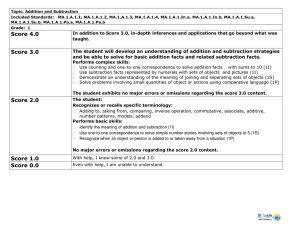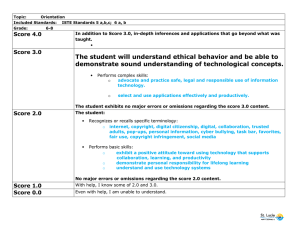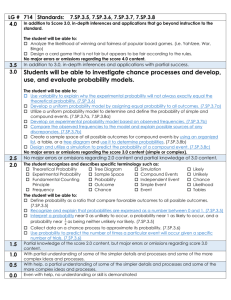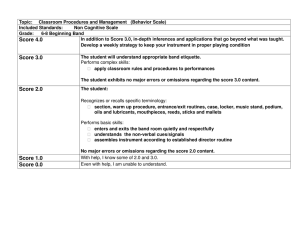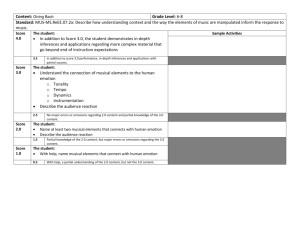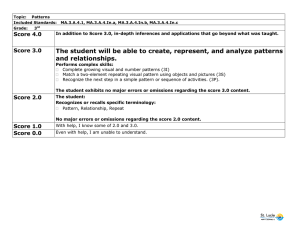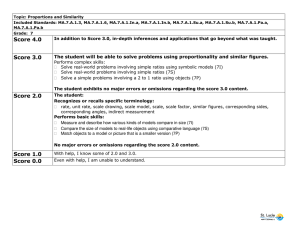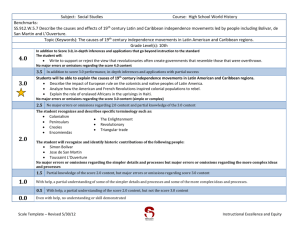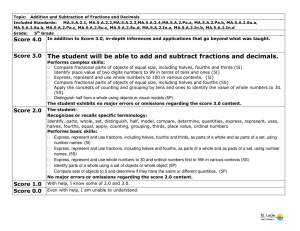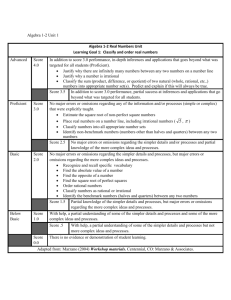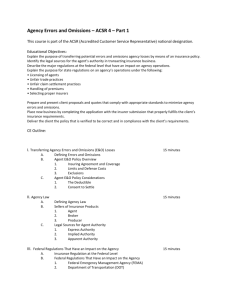Topic: Multiplication and Division
advertisement
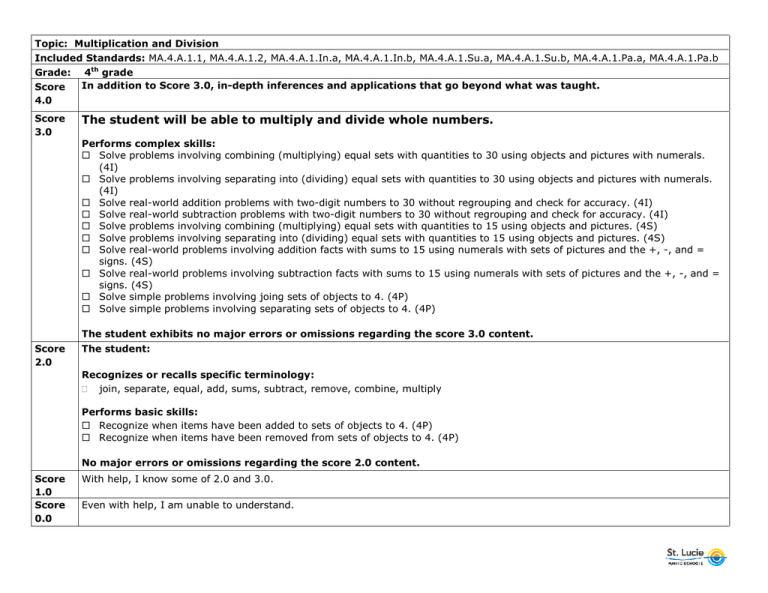
Topic: Multiplication and Division Included Standards: MA.4.A.1.1, MA.4.A.1.2, MA.4.A.1.In.a, MA.4.A.1.In.b, MA.4.A.1.Su.a, MA.4.A.1.Su.b, MA.4.A.1.Pa.a, MA.4.A.1.Pa.b Grade: 4th grade In addition to Score 3.0, in-depth inferences and applications that go beyond what was taught. Score 4.0 Score 3.0 The student will be able to multiply and divide whole numbers. Performs complex skills: Solve problems involving combining (multiplying) equal sets with quantities to 30 using objects and pictures with numerals. (4I) Solve problems involving separating into (dividing) equal sets with quantities to 30 using objects and pictures with numerals. (4I) Solve real-world addition problems with two-digit numbers to 30 without regrouping and check for accuracy. (4I) Solve real-world subtraction problems with two-digit numbers to 30 without regrouping and check for accuracy. (4I) Solve problems involving combining (multiplying) equal sets with quantities to 15 using objects and pictures. (4S) Solve problems involving separating into (dividing) equal sets with quantities to 15 using objects and pictures. (4S) Solve real-world problems involving addition facts with sums to 15 using numerals with sets of pictures and the +, -, and = signs. (4S) Solve real-world problems involving subtraction facts with sums to 15 using numerals with sets of pictures and the +, -, and = signs. (4S) Solve simple problems involving joing sets of objects to 4. (4P) Solve simple problems involving separating sets of objects to 4. (4P) The student exhibits no major errors or omissions regarding the score 3.0 content. Score 2.0 The student: Recognizes or recalls specific terminology: join, separate, equal, add, sums, subtract, remove, combine, multiply Performs basic skills: Recognize when items have been added to sets of objects to 4. (4P) Recognize when items have been removed from sets of objects to 4. (4P) No major errors or omissions regarding the score 2.0 content. Score 1.0 Score 0.0 With help, I know some of 2.0 and 3.0. Even with help, I am unable to understand. Included Standards: MA.4.A.2.1, MA.4.A.2.2, MA.4.A.2.3, MA.4.A.2.4, MA.4.A.2.In.b, MA.4.A.2.In.c, MA.4.A.Su.b, MA.4.A.2.Su.c, MA.4.A.2.Pa.b, MA.4.A.2.Pa.c, MA.4.A.6.In.c, MA.4.A.6.Su.d, MA.4.A.6.Pa.c Grade: 4th grade Score 4.0 In addition to Score 3.0, in-depth inferences and applications that go beyond what was taught. Score 3.0 The student will understand the relationship between fractions, decimals and percent. Performs complex skills: Express and represent fractions, including halves and fourths, as parts of a whole using objects, pictures, and number names. (4I) Express and represent fractions, including halves and fourths, as parts of a set using objects, pictures, and number names. (4I) Represent half and whole using area and sets of objects. (4S) Distinguish parts of objects from whole objects (4P) Recognize a half of an object as part of the whole object. (4P) The student exhibits no major errors or omissions regarding the score 3.0 content. Score 2.0 The student: Recognizes or recalls specific terminology: whole numbers, half, whole, fourths Performs basic skills: Identify relationship between halves, fourths, and a whole (4I) Identify half as a part of a whole. (4S) Match objects to marked spaces to show one-to-one correspondence or quantities 1 to 4. (4P) Match part to whole objects. (4P) No major errors or omissions regarding the score 2.0 content. Score 1.0 With help, I know some of 2.0 and 3.0. Score 0.0 Even with help, I am unable to understand. Topic: Place Value Included Standards: MA.4.A.6.1, MA.4.A.6.6, MA.4.A.2.In.a, MA.4.A.2.Su.a, MA.4.A.2.Pa.a Grade: 4th grade Score 4.0 In addition to Score 3.0, in-depth inferences and applications that go beyond what was taught. Score 3.0 The student will understand place value and be able to represent numbers using place value. Performs complex skills: Apply the concepts of counting, grouping and place value with whole numbers to create sets if tens and ones to identify the value of whole numbers to 50. (4I) Apply the concept of grouping to create sets if tens and ones to 18 as a strategy for counting objects. (4S) Match objects to marked spaces to show one-to-one correspondence or quantities 1 to 4. (4P) The student exhibits no major errors or omissions regarding the score 3.0 content. Score 2.0 The student: Recognizes or recalls specific terminology: Apply, counting, grouping, place value, whole numbers, identify, express, represent, match, distinguish, recognize No major errors or omissions regarding the score 2.0 content. Score 1.0 With help, I know some of 2.0 and 3.0. Score 0.0 Even with help, I am unable to understand. Topic: Algebra Included Standards: MA.4.A.4.1, MA.4.A.4.2, MA.4.A.4.3, MA.4.A.4.In.a, MA.4.A.4.In.b, MA.4.A.In.c, MA.4.A.4.Su.a, MA.4.A.4.Su.b, MA.4.A.4.Su.c, MA.4.A.4.Pa.a, MA.4.A.4.Pa.b, MA.4.A.4.Pa.c Grade: 4th grade In addition to Score 3.0, in-depth inferences and applications that go beyond what was taught. Score 4.0 Score 3.0 The student will be able to generate algebraic rules to describe patterns. Performs complex skills: Identify and extend growing visual and number patterns using strategies, such as skip counting. (4I) Describe equal and unequal sets using terms including greater than, less than, and equal to. (4I) Identify the rule, including 1 less, 2 less, and 3 less, represented in numbers pairs. (4I) Identify and copy two-element repeating visual patterns using objects and pictures. (4S) Determine if the number in two sets of objects to 10 are same or different (equal or unequal) (4S) Indicate the next step in a pattern or sequence of activities. (4P) Use one-to-one correspondence to compare sets of objects to 4 and determine if they are the same or different (equal or unequal). (4P) The student exhibits no major errors or omissions regarding the score 3.0 content. Score 2.0 The student: Recognizes or recalls specific terminology: Pattern, equal, unequal, equal, unequal, greater than, less than, equal to, same, different, skip count Performs basic skills: Use the rule, 1 more, to identify the next number with numbers 1 to 20. (4S) Recognize the quantity of a set of objects to 3 and add 1 more. (4P) No major errors or omissions regarding the score 2.0 content. Score 1.0 Score 0.0 With help, I know some of 2.0 and 3.0. Even with help, I am unable to understand. Topic: Area Included Standards: MA.4.G.3.1, MA.4.G.3.2, MA.4.G.3.3, MA.4.G.3.In.a, MA.4.G.In.b, MA.4.G.In.c, MA.4.G.Su.a., MA.4.G.Su.b, MA.4.G.Su.c, MA.4.G.Pa.a, MA.4.G.Pa.b Grade: 4th Grade In addition to Score 3.0, in-depth inferences and applications that go beyond what was taught. Score 4.0 Score 3.0 The student will understand the concept of area and be able to determine the area of regular and irregular shapes. Performs complex skills: Identify examples of the distance around all sides (perimeter) of squares and rectangles in the environment. (4I) Identify examples of the area of squares and rectangles in the environment. (4I) Find the length of the sides and the area of rectangular and square objects using square units. (4I) Measure whole inches and feet using a ruler to solve real-world linear measurement problems. (4I) Identify examples of the concept of area in the environment. (4S) Count the number of square units of a rectangle marked with a grid to determine its area. (4S) Recognize differences in the length of the sides of rectangles. (4P) The student exhibits no major errors or omissions regarding the score 3.0 content. Score 2.0 The student: Recognizes or recalls specific terminology: perimeter, distance, length, area, measure, square units, inches, sides Performs basic skills: Measure the length of sides of rectangles using whole inches (4S) Identify the sides of a square or rectangle (4P) No major errors or omissions regarding the score 2.0 content. Score 1.0 Score 0.0 With help, I know some of 2.0 and 3.0. Even with help, I am unable to understand. Topic: Geometry (2-Dimensional and 3-Dimensional Figures) Included Standards: MA.4.G.5.3, MA.4.G.5.In.b, MA.4.G.5.In.c, MA.4.G.5.Su.c, MA.4.G.5.Pa.b, MA.4.G.5.Pa.c Grade: 4th grade In addition to Score 3.0, in-depth inferences and applications that go beyond what was taught. Score 4.0 Score 3.0 The student will understand the relationship between a three-dimensional and twodimensional figures. Performs complex skills: Identify examples of two-dimensional figures that are the same shape and size (congruency) and figures that are visually the same on both sides of a central dividing line (symmetry) in the environment. (4I) Locate angles in two-dimensional shapes, including triangles and rectangles. (4I) Identify two-dimensional figures that are visually the same on both sides of a central dividing line (symmetry). (4S) Recognize the two sides of a two-dimensional figure created by a central dividing line (symmetry). (4P) The student exhibits no major errors or omissions regarding the score 3.0 content. Score 2.0 The student: Recognizes or recalls specific terminology: same size, congruent, symmetry, cone, cube, cylinder, rectangular prism, sphere, two-dimensional, threedimensional, triangle, rectangle Performs basic skills: Sort three-dimensional objects, such as cubes, cylinders, cones, rectangular prisms, and spheres. (4I) Match three-dimensional objects, with models, such as a cube, cylinder, cone, and sphere. (4S) Recognize three-dimensional objects, such as ball (sphere), block (cube), or tube (cylinder). (4P) No major errors or omissions regarding the score 2.0 content. Score 1.0 Score 0.0 With help, I know some of 2.0 and 3.0. Even with help, I am unable to understand. Topic: Geometry (Angles) Included Standards: MA.4.G.5.1, MA.4.G.5.In.a, MA.4.G.5.Su.a, MA.4.G.5.Pa.a Grade: 4th grade In addition to Score 3.0, in-depth inferences and applications that go beyond what was taught. Score 4.0 Score 3.0 The student will understand the classification of angles. Performs complex skills: Locate angles in two-dimensional shapes, including triangles and rectangles. (4I) Locate angles within a triangle.(4S) Recognize corners (angles) in common objects with two-dimensional shapes, such as a square or rectangle. (4P) The student exhibits no major errors or omissions regarding the score 3.0 content. Score 2.0 The student: Recognizes or recalls specific terminology: angles, corners, triangle, rectangle No major errors or omissions regarding the score 2.0 content. Score 1.0 Score 0.0 With help, I know some of 2.0 and 3.0. Even with help, I am unable to understand. Topic: Numbers and Operations (On-Going) Included Standards: MA.4.A.6.1, MA.4.A.6.2, MA.4.A.6.3, MA.4.A.6.4, MA.4.A.6.5, MA.4.A.6.6, MA.4.A.6.In.a, MA.4.A.6.In.b, MA.4.A.6.In.d, MA.4.A.6.In.e, MA.4.A.6.Su.a, MA.4.A.6.Su.b, MA.4.A.6.Su.c, MA.4.A.6.Su.e, MA.4.A.6.Su.f, MA.4.A.6.Pa.a, MA.4.A.6.Pa.b, Grade: 4th grade In addition to Score 3.0, in-depth inferences and applications that go beyond what was taught. Score 4.0 Score 3.0 The student will be able to use various strategies to solve non-routine problems. Performs complex skills: Express, represent, and use whole numbers to 50 in various contexts (4I) Use the inverse relationship of addition and subtraction as a strategy to solve problems. (4I) Use skip counting by 5s and 10s to determine amounts to 50. (4I) Use strategies such as comparing and grouping to estimate quantities to 20. (4I) Express, represent, and use whole numbers to 25 using sets of objects and pictures, number names, and numerals in various contexts. (4S) Use ordinal numbers, including first and second, in real-world situations. (4S) Use objects and pictures to represent the relationship between addition with sums to 15 and related subtraction facts. (4S) Separate quantities to 25 into equal sets and identify the total number of sets and the number in each set. (4S) Use strategies such as comparing and grouping to estimate quantities to 10. (4S) Use quantities to 4 represented by objects, pictures, or number names in various contexts. (4P) The student exhibits no major errors or omissions regarding the score 3.0 content. Score 2.0 The student: Recognizes or recalls specific terminology: inverse, addition, subtraction, comparing, grouping, half, whole, equal sets, estimate, separate, ordinal numbers No major errors or omissions regarding the score 2.0 content. Score 1.0 Score 0.0 With help, I know some of 2.0 and 3.0. Even with help, I am unable to understand.
